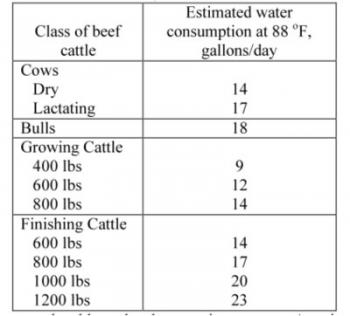Considerations For Water During Drought

Cattle water requirements may double during hot weather. If cattle do not meet their water needs, they may refuse to eat, experience lowered production, and become sick. This table provided estimates of water consumption for cattle:
During the heat of the summer in New Mexico, a good rule of thumb is to "budget" 30 gallons of available water per cow. This will provide a cushion for evaporation, leakages, and unanticipated storage losses-its bound to happen. In some areas you may be able to develop a spring or seep. A spring with a flow rate of 1 / 2 gallon per minute provides 720 gallons per day. Consider the possibility of installing a larger storage tank and piping water to troughs. You may need to install high-pressure plastic pipe to carry water from a central source. Although expensive initially, pipelines will prove useful for many years.
As previously mentioned, increased water distribution can enhance forage utilization. Hauling stock water is expensive and time consuming, but may be a viable strategy in some situations. One concern about cattle drink stagnant pond water during hot, dry weather is that animals can die if water contains certain species of blue-green algae. If concentrations of blue-green algae are suspected, walk around to the windy side of the body of water. If any dead animals such as mice, muskrats, birds, snakes, or fish are present assume a poisonous condition exists. Copper sulfate is most commonly used to treat toxic water. Eight pounds of copper sulfate per 1,000,000 gallons of water is usually considered the upper level of treatment.